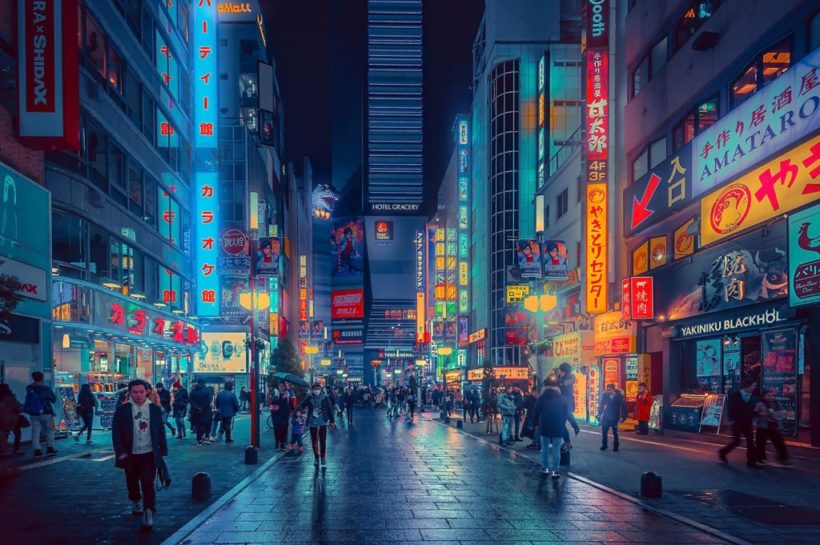Step onto the streets of a bustling city at night, and you’ll be greeted by a symphony of lights that captivate and guide. Among these luminous wonders, neon signs shine brightest, effortlessly drawing our attention with their vibrant colors and unique glow. Have you ever wondered about the fascinating process behind creating these captivating works of art?
Welcome to our blog, where we embark on an illuminating journey into the world of neon sign manufacturing. In this series, we will delve into the craftsmanship, science, and creativity that bring neon signs to life, lighting up the streets and captivating our imaginations.
From the meticulous bending of glass tubes to the magical chemistry of gases and electrodes, we’ll explore the step-by-step process of how neon signs are made. Join us as we uncover the artistry and precision required to shape the night with these iconic displays.
But it’s not just about the technical aspects; it’s about the art of storytelling through light. Neon signs have a unique ability to convey messages, evoke emotions, and become beacons of identity for businesses and communities. We’ll delve into the creative process behind designing these stunning displays, exploring how colors, shapes, and typography come together to create unforgettable visual experiences.
Whether you’re an admirer of neon art, a design enthusiast, or simply curious about the magic that lights up our streets, this blog is for you. Get ready to witness the fusion of art and science as we unravel the secrets behind the creation of neon signs. Together, let’s illuminate our understanding of these captivating luminaires in “Lighting up the Streets: How Neon Signs Are Made.”
The Art of Neon: A Journey into the Craftsmanship
Neon signs are not just sources of light; they are intricate works of art that require a high level of craftsmanship and skill. The process of creating a neon sign involves a delicate dance of bending glass tubes, manipulating electrodes, and infusing them with noble gases to achieve that distinctive vibrant glow.
At the heart of the art of neon lies the painstaking process of tube bending. Skilled artisans, known as tube benders, take slender glass tubes and gently heat them over an open flame. With precision and expertise, they use a combination of heat and carefully applied pressure to bend the tubes into the desired shapes and curves. This requires a steady hand and a deep understanding of the properties of glass, as even the slightest miscalculation can result in breakage.
The tube bending process is an art form in itself, as it requires not only technical proficiency but also creativity. Master tube benders can bring intricate designs and typography to life, turning a simple glass tube into a flowing script or a geometric pattern. Each bend is carefully calculated to achieve the desired effect, ensuring that the final product captures the vision of the designer.
Once the glass tubes are shaped, they are cleaned thoroughly to remove any impurities that may interfere with the illumination. The next step involves the insertion of electrodes into the tubes. These electrodes are typically made of metal, such as copper or iron, and are carefully sealed to create a vacuum within the tube. This vacuum ensures that the gases inside the tube can properly interact and produce the glowing effect.
The final and most magical step of the process is the infusion of noble gases. Neon gas is the most commonly used gas, giving the classic orange-red glow, but other gases like argon and helium can be used to achieve different colors. When a high voltage is applied to the electrodes, it excites the gas particles, causing them to emit light. The specific combination of gas and voltage determines the color and intensity of the light emitted.
The art of neon sign making is a labor-intensive and precise craft that requires a fusion of technical knowledge, artistic vision, and manual dexterity. Each neon sign is a testament to the skill and creativity of the artisans involved, as they transform simple materials into mesmerizing works of art that light up our streets and leave a lasting impression on all who encounter them.
From Glass Tubes to Glowing Spectacles: The Process of Neon Tube Bending
The process of neon tube bending is a delicate and intricate art form that brings the glass tubes to life, transforming them into the mesmerizing glowing spectacles we associate with neon signs. This meticulous process requires a combination of skill, precision, and creativity to shape the tubes into captivating forms.
The journey of neon tube bending begins with selecting the appropriate glass tubes. These tubes are typically made of durable and heat-resistant borosilicate glass, chosen for its ability to withstand the high temperatures required during the bending process. The tubes come in various diameters and lengths, allowing for flexibility in creating signs of different sizes and designs.
To start, the tube bender carefully heats a section of the glass tube using a high-temperature flame. The flame is typically produced by a specialized torch that combines a mixture of gases, such as hydrogen and oxygen or propane and oxygen, to achieve the necessary heat intensity. The bender skillfully rotates the tube in the flame, evenly distributing the heat to avoid overheating or causing weak spots in the glass.
As the glass reaches its malleable state, the bender gently applies pressure and uses tools such as metal rods or graphite paddles to shape the tube. This process requires a remarkable level of control and finesse, as the bender must work quickly and efficiently to maintain the desired shape before the glass cools and solidifies. The bender’s skilled hands guide the glass, coaxing it into graceful curves, sharp angles, or intricate lettering, all while keeping a keen eye on maintaining the structural integrity of the tube.
The artistry of neon tube bending is not limited to simple bends. Talented tube benders can create complex designs by incorporating multiple bends, twists, and intersections within a single tube. They utilize various techniques such as ribboning (creating parallel bends), swiveling (rotating the tube while bending), and crossfire bending (creating bends at different angles) to achieve intricate patterns and shapes.
Throughout the process, tube benders may use templates or patterns as guides to ensure accuracy and consistency in the shape and size of the bends. However, experienced benders often rely on their expertise and muscle memory, relying on their intuition to create visually appealing and structurally sound designs.
Once the desired shape is achieved, the glass tube is carefully cooled to solidify the bend and retain its form. The bender may use a water bath or specialized cooling equipment to expedite the cooling process without compromising the integrity of the glass.
The art of neon tube bending is a labor-intensive craft that requires a blend of technical skill, artistic vision, and years of experience. Each bend is a testament to the craftsmanship and dedication of the bender, as they shape the glass with precision and transform it into a conduit for captivating light. The mastery of neon tube bending is what allows us to enjoy the vibrant and enchanting glow of neon signs, lighting up the streets and captivating our senses.
Colors, Gases, and Electrodes: The Science Behind Neon Sign Illumination
Behind the mesmerizing colors and radiant glow of neon signs lies a fascinating scientific process that brings them to life. The illumination of neon signs is achieved through a combination of specific gases, electrodes, and the interaction of electrical currents.
The first key element in creating the vibrant colors of neon signs is the selection of noble gases. While neon gas is commonly associated with the classic orange-red glow, other gases like argon, helium, and krypton can be used to produce a wide range of colors. Each gas has its unique spectral properties, emitting light at different wavelengths when excited by electrical currents.
To initiate the illumination, electrodes are inserted into the glass tubes during the fabrication process. These electrodes are typically made of metal, such as iron or copper, and are carefully sealed to create a vacuum within the tube. The vacuum prevents interference from external elements and enables the gases inside the tube to interact solely with the electrodes.
When a high voltage is applied to the electrodes, a process known as ionization occurs. This ionization causes electrons within the gas atoms to become excited and jump to higher energy levels. As the excited electrons return to their original energy levels, they release energy in the form of photons, which we perceive as light. The specific energy levels of the gas atoms determine the color emitted, resulting in the characteristic hues of neon signs.
To achieve different colors within a single sign, multiple gases or a mixture of gases can be used in separate sections of the glass tubes. By controlling the combination of gases and the applied voltage, sign makers can create intricate color patterns and gradients, further enhancing the visual impact of the sign.
Achieving the desired brightness and intensity of the illumination involves finding the optimal balance between the voltage applied and the distance between the electrodes. Sign makers carefully adjust these factors to ensure that the electrical current flows smoothly through the gas, resulting in a steady and uniform glow along the length of the tube.
The science behind neon sign illumination is a precise interplay between the properties of gases, electrical currents, and the manipulation of energy levels within the gas atoms. Understanding these principles allows sign makers to create stunning visual displays that captivate our attention and transform the nighttime landscape.
Next time you find yourself marveling at the dazzling array of colors emanating from a neon sign, take a moment to appreciate the scientific marvel happening behind the scenes. The fusion of science and artistry in neon sign creation brings us the joy and wonder of these radiant beacons that light up our streets and add a touch of magic to our surroundings.
Shaping the Night: Designing and Creating Stunning Neon Sign Displays
Beyond the technical aspects of neon sign production, the art of designing and creating visually captivating displays plays a crucial role in shaping the night and leaving a lasting impression on viewers. This process involves a combination of artistic vision, understanding of branding and messaging, and expertise in working with neon as a medium.
Designing a neon sign begins with a clear understanding of the purpose and desired impact of the display. Whether it’s to attract attention to a business, evoke a particular mood, or convey a specific message, the design process starts with defining the objectives. This includes considering factors such as the target audience, the location of the sign, and the surrounding environment.
Sign designers work closely with clients to translate their vision into a visual representation. They consider the brand identity, incorporating elements such as logos, typography, and color schemes to ensure consistency and reinforce brand recognition. The designer’s artistic flair comes into play as they explore creative ways to bring the brand to life through the unique characteristics of neon.
One of the distinctive features of neon signs is the ability to create custom shapes and intricate designs. Designers leverage this flexibility to craft visually striking displays that capture attention and make a statement. They experiment with different lettering styles, forms, and arrangements to achieve the desired aesthetic impact, carefully considering legibility and visual balance.
To aid in the design process, designers may utilize software or hand-drawn sketches to create mock-ups and provide clients with a visual representation of the proposed sign. This allows for feedback and refinement before moving forward with the production.
Once the design is finalized, the production phase begins. Skilled craftsmen work hand in hand with the designer to bring the vision to life. They carefully select the appropriate glass tubes, bending and shaping them with precision according to the design specifications. Attention to detail is paramount, ensuring that each bend and curve is faithful to the original design.
The choice of gases and electrodes also plays a role in realizing the design intent. Designers and craftsmen collaborate to determine the ideal combination of gases that will produce the desired colors and effects, enhancing the overall visual impact of the sign.
The installation process is the final step in bringing the design to fruition. Professionals with expertise in electrical wiring and sign installation ensure that the neon sign is securely and safely mounted, with the electrical connections properly established. This stage requires meticulous attention to detail to ensure that the sign functions optimally and complies with safety regulations.
When night falls, and the neon sign comes to life, it transforms the surrounding space, captivating passersby and creating an ambiance that is both nostalgic and contemporary. The interplay of design, craftsmanship, and the luminous qualities of neon results in stunning displays that become iconic landmarks, shaping the night and leaving a lasting impression on all who encounter them.
In the world of neon sign creation, the fusion of design and craftsmanship is what turns a simple concept into a remarkable work of art. Through their visionary designs and masterful execution, designers and craftsmen contribute to the tapestry of urban landscapes, illuminating the night with stunning displays that become beacons of identity, creativity, and inspiration.















